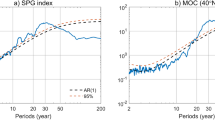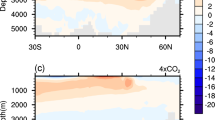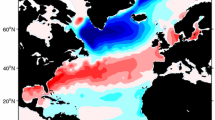Abstract
The physical processes underlying the internal component of the Atlantic Multidecadal Variability (AMV) are investigated from a 1,000-yr pre-industrial control simulation of the CNRM-CM5 model. The low-frequency fluctuations of the Atlantic Meridional Overturning Circulation (AMOC) are shown to be the main precursor for the model AMV. The full life cycle of AMOC/AMV events relies on a complex time-evolving relationship with both North Atlantic Oscillation (NAO) and East Atlantic Pattern (EAP) that must be considered from a seasonal perspective in order to isolate their action; the ocean is responsible for setting the multidecadal timescale of the fluctuations. AMOC rise leading to a warm phase of AMV is statistically preceded by wintertime NAO+ and EAP+ from ~Lag −40/−20 yrs. Associated wind stress anomalies induce an acceleration of the subpolar gyre (SPG) and enhanced northward transport of warm and saline subtropical water. Concurrent positive salinity anomalies occur in the Greenland–Iceland–Norwegian Seas in link to local sea-ice decline; those are advected by the Eastern Greenland Current to the Labrador Sea participating to the progressive densification of the SPG and the intensification of ocean deep convection leading to AMOC strengthening. From ~Lag −10 yrs prior an AMOC maximum, opposite relationship is found with the NAO for both summer and winter seasons. Despite negative lags, NAO− at that time is consistent with the atmospheric response through teleconnection to the northward shift/intensification of the Inter Tropical Convergence Zone in link to the ongoing warming of tropical north Atlantic basin due to AMOC rise/AMV build-up. NAO− acts as a positive feedback for the full development of the model AMV through surface fluxes but, at the same time, prepares its termination through negative retroaction on AMOC. Relationship between EAP+ and AMOC is also present in summer from ~Lags −30/+10 yrs while winter EAP− is favored around the AMV peak. Based on additional atmospheric-forced experiments, both are interpreted as the local seasonal-dependent atmospheric response to warmer North Atlantic. Finally, advection of fresher water from the tropical basin created by local atmosphere/ocean anomalous circulation on one hand and from the Arctic on the other hand due to large-scale sea ice melting leads to decrease of density in the SPG and contributes terminating the model AMOC/AMV events. All together, the combined effects of NAO and EAP, their intertwined seasonal forcing/forced role upon/by the ocean and the primary role of salinity anomalies associated with oceanic dynamical changes acting as an integrator are responsible in CNRM-CM5 for an irregular and damped mode of variability for AMOC/AMV that takes about 35–40 (15–20) years to build up (dissipate).
















Similar content being viewed by others
References
Bellucci A et al (2014) An assessment of a multi-model ensemble of decadal climate predictions. Clim Dyn. doi:10.1007/s00382-014-2164-y
Danabasoglu G et al (2014) North Atlantic simulations in coordinated Ocean-ice reference experiments phase II (CORE-II). Part I: mean states. Ocean Model. doi:10.1016/j.ocemod.2013.10.005
Voldoire A et al (2013) The CNRM-CM5.1 global model: description and basic evaluation. Clim Dyn. doi:10.1007/s00382-011-1259-y
Zhang R et al (2013) Have aerosols caused the observed Atlantic multidecadal variability? J Atmos Sci. doi:10.1175/JAS-D-12-0331.1
Antonov JI, Locarnini RA, Boyer TP, Mishonov AV, Garcia HE (2006) World Ocean Atlas 2005, vol 2: salinity. In Levitus S (ed) NOAA Atlas NESDIS 62, US Government Printing Office, Washington, DC
Barnston AG, Livezey RE (1987) Classification, seasonality and persistence of low-frequency atmospheric circulation patterns. Mon Wea Rev 115:1083–1126
Barrier N, Cassou C, Treguier AM, Deshayes (2013) Response of North-Atlantic Ocean circulation to atmospheric weather regimes. J Phys Ocean. doi:10.1175/JPO-D-12-0217.1
Bentsen M, Drange H, Furevik T, Zhou T (2004) Simulated variability of the Atlantic meridional overturning circulation. Clim Dyn 22:701–720
Biastoch A, Böning CW, Getzlaff J, Molines JM, Madec G (2008) Causes of interannual-decadal variability in the meridional overturning circulation of the midlatitude North Atlantic Ocean. J Clim 21:6599–6615
Booth BBB, Dunstone NJ, Halloran PR, Andrews T, Bellouin N (2012) Aerosols implicated as a prime driver of twentieth-century North Atlantic climate variability. Nature 484:228–232
Born A, Mignot J (2012) Dynamics of decadal variability in the Atlantic subpolar gyre: a stochastically forced oscillator. Clim Dyn. doi:10.1007/s00382-011-1180-4
Brambilla E, Talley LD (2008) Subpolar mode water in the northeastern Atlantic: 1. Averaged properties and mean circulation. J Goephy Res 113:C04025. doi:10.1029/2006JC004062
Cassou C, Terray L, Hurrell JW, Deser C (2004a) North Atlantic winter climate regimes: spatial asymmetry, stationarity with time and oceanic forcing. J Clim 17:1055–1068
Cassou C, Deser C, Terray L, Hurrell JW, Drévillon M (2004b) Summer sea surface temperature conditions in the north atlantic and their impact upon the atmospheric circulation in early winter. J Clim 17:3349–3363
Chang CY, Chiang JCH, Wehner MF, Friedman AR, Ruedy R (2011) Sulfate aerosol control of tropical Atlantic climate over the twentieth century. J Clim 24(10):2540–2555
Chiang JCH, Cjang CY, Wehner MF (2013) Long-term behavior of the Atlantic Interhemispheric SST gradient in the CMIP5 historical simulations. J Clim 26:8628–8640
Cunningham SA et al (2007) Temporal variability of the Atlantic Meridional Overturning circulation at 26.5°N. Science 317:938–945
Danabasoglu G (2008) On multi-decadal variability of the Atlantic meridional overturning circulation in the community climate system model version 3 (CCSM3). J Clim 21:5524–5544
Davison AC, Hinkley DV (1997) Bootstrap methods and their application. Cambridge University Press, Cambridge
de Boyer Montégut C, Madec G, Fischer AS, Lazar A, Iudicone D (2004) Mixed layer depth over the global ocean: an examination of profile data and a profile-based climatology. J Geophys Res 109:C12003. doi:10.1029/2004JC002378
DelSole T, Tippett MK, Shukla J (2011) A significant component of unforced multidecadal variability in the recent acceleration of global warming. J Clim 24:909–926
Delworth TL, Greatbatch RJ (2000) Multidecadal thermohaline circulation variability driven by atmospheric surface flux forcing. J Clim 13:1481–1495
Delworth TL, Mann ME (2000) Observed and simulated multidecadal variability in the Northern Hemisphere. Clim Dyn 16:661–676
Delworth TL, Manabe S, Stouffer R (1993) Interdecadal variations of the thermohaline circulation in a coupled ocean–atmosphere model. J Clim 6:1993–2011
Déqué M, Dreveton C, Braun A, Cariolle D (1994) The ARPEGE-IFS atmosphere model: a contribution to the French community climate modelling. Clim Dyn 10:249–266
Deser C, Knutti R, Solomon S, Phillips AS (2012) Communication of the role of natural variability in future North American climate. Nat Clim Change 2:775–779. doi:10.1038/nclimate1562
Deshayes J, Frankignoul C (2008) Simulated variability of the circulation in the North Atlantic from 1953 to 2003. J Clim 21:4919–4930
Deshayes J, Curry R, Msadek M (2014) CMIP5 model inter-comparison of freshwater budget and circulation in the North Atlantic. J Clim 27:3298–3317
Dong B, Sutton RT (2005) Mechanism of interdecadal thermohaline circulation variability in a coupled ocean–atmosphere GCM. J Clim 18:1117–1135
Duchon C (1979) Lanczos filtering in one and two dimensions. J Appl Meteorol 1016–1022
Eden C, Willebrand J (2001) Mechanism of interannual to decadal variability of the North Atlantic circulation. J Clim 14:2266–2280
Enfield D, Mestas-Nunez A, Trimble P (2001) The Atlantic multidecadal oscillation and its relation to rainfall and river flows in the continental U.S. Geophys Res Lett 28:2077–2080
Folland CK, Colman AW, Rowell DP, Davey MK (2001) Predictability of northeast Brazil rainfall and real-time forecast skill, 1987–98. J Clim 14:1937–1958
Fontaine B, Janicot S, Roucou P (1999) Coupled ocean–atmosphere surface variability and its climate impacts in the tropical Atlantic region. Clim Dyn 15:451–473
Ganachaud A, Wunsch C (2000) The oceanic meridional overturning circulation, mixing, bottom water formation, and heat transport. Nature 408:453–457
Gastineau G, Frankignoul C (2012) Cold-season atmospheric response to the natural variability of the Atlantic meridional overturning circulation. Clim Dyn 39(1–2):37–57
Goldenberg SB, Landsea CW, Mestas-Nuñez AM, Gray WM (2001) The recent increase in Atlantic hurricane activity: causes and implications. Science 293:474–479
Graham JA, Stevens DP, Heywood KJ, Wang Z (2011) North Atlantic climate responses to perturbations in Arctic Intermediate Water. Clim Dyn 37:297–311
Gray ST, Graumlich LJ, Betancourt JL, Pederson GT (2004) A tree-ring based reconstruction of the Atlantic Multidecadal Oscillation since 1567 A.D. Geo Res Lett 31:L12205. doi:10.1029/2004GL019932
Griffies SM, Tziperman E (1995) A linear thermohaline oscillator riven by stochastic atmospheric forcing. J Clim 8:2440Ð2453
Griffies SM et al (2009) Coordinated ocean-ice experiments (COREs). Ocean Mod 26:1–46. doi:10.1016/j.ocemod.2008.08.007
Guemas V, Salas-Melia D (2008) Simulation of the Atlantic Meridional Overturning circulation in an Atmosphere-Ocean global coupled model. Part I: a mechanism governing the variability of ocean convection in a preindustrial experiment. Clim Dyn 31:29–48. doi:10.1007/s00382-007-0336-8
Gupta AS, Muir LC, Brown JN, Phipps SJ, Durack PJ, Monselesan D, Wijffels SE (2012) Climate drift in the CMIP3 models. J Clim 25:4621–4640
Hakkinen S, Rhines PB (2004) Decline of subpolar North Atlantic Circulation during the 1990s. Science 304:555
Hakkinen S, Rhines PB, Worthen DL (2011) Atmospheric blocking and Atlantic Multidecadal Ocean variability. Science 3334:655–659
Hawkins E, Sutton R (2007) Variability of the Atlantic thermohaline circulation described by three-dimensional empirical orthogonal functions. Clim Dyn 29:745–762
Hawkins E, Sutton R (2012) Time of emergence of climate signals. Geophys Res Lett. doi:10.1029/2011GL050087
Hegerl G, Zwiers F, Braconnot P, Gillet N, Luo Y, Marengo Orsini J, Nicholls N, Penner J, Stott P (2007) Understanding and attributing climate change. In: Solomon S et al (eds) Climate change 2007: the physical science basis, Cambridge University Press, Cambridge, pp 663–745
Hodson DLR, Sutton RT (2012) The impact of resolution on the adjustment and decadal variability of the Atlantic meridional overturning circulation in a coupled climate model. Clim Dyn 39:3057–3073. doi:10.1007/s00382-012-1309-0
Hodson DLR, Sutton RT, Cassou C, Keenlyside N, Okumura Y, Zhou T (2011) Climate impacts of recent multidecadal changes in Atlantic Ocean Sea surface temperature: a multimodel comparison. Clim Dyn 34(7–8):1041–1058. doi:10.1007/s00382-009-0571-2
Hurrell JW, Kushnir Y, Otterson G, Visbeck M (2003) An overview of the North Atlantic Oscillation. The North Atlantic Oscillation: climate significance and environmental impact. Geophys Monogr 134 (American Geophysical Union 1:35)
Jackson L, Vellinga M (2013) Multidecadal to centennial variability of the AMOC: HadCM3 and a perturbed physics ensemble. J Clim 26:2390–2407
Jungclaus J, Haak H, Latif M, Mikolajewicz U (2005) Arctic-North Atlantic interactions and multi-decadal variability of the meridional overturning circulation. J Clim 18:4013–4031
Kerr RA (2000) A North Atlantic climate pacemaker for the centuries. Science 288:1984–1985
Knight JR (2009) The Atlantic multidecadal oscillation inferred from the forced climate response in coupled general circulation models. J Clim 22:1610–1625. doi:10.1175/2008JCLI2628.1
Knight JR, Allan RJ, Folland CK, Vellinga M, Mann ME (2005) A signature of persistent natural thermohaline circulation cycles in observed climate. Geophys Res Lett 32:L20708. doi:10.1029/2005GL024233
Krahmann G, Visbeck M, Reverdin G (2001) Formation and propagation of temperature anomalies along the North Atlantic Current. J Phys Oceanogr 31:1287–1303
Kushnir Y, Robinson WA, Bladé I, Hall NMJ, Peng S, Sutton R (2002) Atmospheric GCM Response to extratropical SST anomalies: synthesis and evaluation. J Clim 15:2233–2256
Kwon YO, Frankignoul C (2012) Stochastically-driven multidecadal variability of the Atlantic meridional overturning circulation in CCSM3. Clim Dyn 38:859–876
Levermann A, Born A (2007) Bistability of the Atlantic subpolar gyre in a coarse-resolution model. Geophys Res Lett 34:L24605
Locarnini RA, Mishonov AV, Antonov JI, Boyer TP, Garcia HE (2006) World Ocean Atlas 2005, vol 1: temperature. In Levitus S (ed) NOAA Atlas NESDIS 61, U.S. Government Printing Office, Washington, DC
Lucarini V, Ragone F (2011) Energetics of PCMDI/CMIP3 climate models: energy budget and meridional enthalpy transport. Rev Geophys 49:RG1001. doi:10.1029/2009RG000323
Madec G (2008) NEMO ocean engine. Note du Pole de modélisation, Institut Pierre-Simon Laplace (IPSL), France, No 27 ISSN No 1288–1619
Marini C, Frankignoul C, Mignot J (2011) Links between the southern annular mode and the Atlantic Meridional Overturning Circulation in a climate model. J Clim 24(3):624–640
Marshall J, Johnson H, Goodman J (2001) A study of the interaction of the North Atlantic Oscillation with ocean circulation. J Clim 14:1399–1421
McCabe G, Palecki M, Betancourt J (2004) Pacific and Atlantic Ocean influences on multi-decadal drought frequency in the United States. Proc Natl Acad Sci 101:4136–4141
Medhaug I, Furevik T (2011) North Atlantic 20th century multidecadal variability in coupled climate models: sea surface temperature and ocean overturning circulation. Ocean Sci 7:389–404. doi:10.5194/os-7-389-2011
Medhaug I, Langehaug HR, Eldevik T, Furevik T (2011) Mechanisms for multidecadal variability in a simulated Atlantic Meridional Overturning Circulation. Clim Dyn 39:77–93. doi:10.1007/s00382-011-1124-z
Meehl G, Goddard L, Murphy J, Stouffer RJ, Boer G, Danabasoglu G, Dixon K, Giorgetta MA, Greene AM, Hawkins E, Hegerl G, Karoly D, Keenlyside N, Kimoto M, Kirtman B, Navarra A, Pulwarty R, Smith D, Stammer D, Stockdale T (2009) Decadal prediction can it be skilful ? Bull Am Meteorol Soc. doi:10.1175/2009BAMS2778.1
Meehl GA, Arblaster JM, Fasullo J, Hu A, Trenberth KE (2011) Model-based 595 evidence of deep ocean heat uptake during surface temperature hiatus periods. Nature Clim Change 1:360–364. doi:10.1038/NCLIMATE1229
Meinen CS, Baringer MO, Garcia RF (2010) Florida current transport variability: an analysis of annual and longer-period signals. Deep Sea Res Part I Oceanogr Res Pap 57(7):835–846
Menary BMB, Park W, Lohmann K, Vellinga M, Palmer MD, Latif M, Junclaus JH (2012) A multimodel comparison of centennial Atlantic meridional overturning circulation variability. Clim Dyn 38:2377–2388. doi:10.1007/s00382-011-1172-4
Mignot J, Frankignoul C (2005) The variability of the Atlantic meridional overturning circulation, the North Atlantic Oscillation, and the El Ninõ-Southern Oscillation in the Bergen climate model. J Clim 18:2361–2375
Mignot J, Frankignoul C (2010) Local and remote impacts of a tropical Atlantic salinity anomaly. Clim Dyn 35:1133–1147
Mohino E, Janicot S, Bader J (2011) Sahel rainfall and decadal to multi-decadal sea surface temperature variability. Clim Dyn. doi:10.1007/s00382-010-0867-2
Msadek R, Frankignoul C (2009) Atlantic multidecadal oceanic variability and its influence on the atmosphere in a climate model. Clim Dyn 33:45–62. doi:10.1007/s00382-008-0452-0
Msadek R, Frankignoul C (2010) Mechanisms of the atmospheric response to North Atlantic multidecadal variability: a model study. Clim Dyn. doi:10.1007/s00382-010-0958-0
Nilsen JEØ, Gao Y, Drange H, Furevik T, Bentsen M (2003) Simulated North Atlantic-Nordic Seas water mass exchanges in an isopycnic coordinate OGCM. Geophys Res Lett 30(10):1536. doi:10.1029/2002GL016597
Noilhan J, Planton S (1989) A simple parameterization of land surface processes for meteorological models. Mon Wea Rev 117:536–549
Oki T, Sud YC (1998) Design of total runoff integrating pathways (TRIP). A global river channel network. Earth Interact 2:1–36
Okumura Y, Xie SP (2001) Tropical Atlantic air-sea intercation and its influence on the NAO. Geophys Res Lett 28(8):157–1510
Otterå OH, Bentsen M, Drange H, Suo L (2010) External forcing as a metronome for Atlantic multidecadal variability. Nature Geosci 3(10):688–694
Reverdin G, Niiler PP, Valdimarsson H (2003) North Atlantic Ocean surface currents. J Geophys Res 108(C1):3002. doi:10.1029/2001JC001020
Salas y Mélia D (2002) A global coupled sea ice-ocean model. Ocean Model 4:137–172
Schlesinger ME, Ramankutty N (1994) An oscillation in the global climate system of period 65–70 years. Nature 367:723–726
Stocker T (1998) The seesaw effect. Science 282:61–62
Sutton R, Dong B (2012) Atlantic Ocean influence on a shift in European climate in the 1990s. Nat Geo 5:788-792. doi:10.1038/ngeo1595
Sutton RT, Hodson DLR (2005) Atlantic Ocean forcing of North American and European summer climate. Science 309:115–118
Sutton RT, Norton WA, Jewson SP (2001) The North Atlantic Oscillation—what role for the ocean? Atmos Sci Lett 1:89–100
Swingedouw D, Mignot J, Labetoulle S, Gilardi E, Madec G (2013) Initialisation and predictability of the AMOC over the last 50 years in a climate model. Clim Dyn 40:23981–23990. doi:10.1007/s00382-012-1516-8
Taylor KE, Stouffer RJ, Meehl GA (2012) An overview of CMIP5 and the experiment design. Bull Am Meteorol Soc 93:485–498. doi:10.1175/BAMS-D-11-00094.1
Terray L (2012) Evidence for multiple drivers of North Atlantic multi-decadal climate variability. Geo Res Lett 39:L19712. doi:10.1029/2012GL053046
Timmermann A, Latif M, Voss R, Groetzner A (1998) Northern Hemispheric interdecadal variability: a coupled air-sea mode. J Clim 11:1906–1931
Ting M, Kushnir Y, Seager R, Li C (2009) Forced and internal twentieth-century SST in the North Atlantic. J Clim 22:1469–1881. doi:10.1175/2008JCLI2561.1
Torrence C, Compo GP (1998) A practical guide to wavelet analysis. Bull Am Meteorol Soc 79:61–78
Trenberth KE, Shea DJ (2006) Atlantic hurricanes and natural variability in 2005. Geophys Res Lett 33:L12704. doi:10.1029/2006GL026894
Valcke S (2013) The OASIS3 coupler: a European climate modelling community software. Geosci Model Dev 6:373–388. doi:10.5194/gmd-6-373-2013
Vellinga M, Wu P (2004) Low-latitude fresh water influence on centennial variability of the thermohaline circulation. J Clim 17:4498–4511
Vimont JV, Kossin JP (2007) The Atlantic Meridional mode and hurricane activity. Geophys Res Lett 34:L07709. doi:10.1029/2007GL029683
Wang C, Dong S, Evan AT, Foltz GR, Lee SK (2012) Multidecadal covariability of North Atlantic sea surface temperature, African dust, Sahel rainfall and Atlantic hurricanes. J Clim 25:5404–5415
Willis JK (2010) Can in situ floats and satellite altimeters detect longterm changes in Atlantic Ocean overturning? Geophys Res Lett 37:L06602. doi:10.1029/2010GL042372
Wouters B, Drijfhout S, Halzeleger W (2012) Interdecadal North-Atlantic meridional overturning circulation variability in EC-EARTH. Clim Dyn. doi:10.1007/v00382-012-1366-4
Wunsch C (2002) What is the thermohaline circulation? Science 298:1179–1180
Zhang R (2007) Anticorrelated multidecadal variations between surface and subsurface tropical North Atlantic. Geophys Res Lett 34:L12713. doi:10.1029/2007GL030225
Zhang R, Delworth TL (2005) Simulated tropical response to a substantial weakening of the Atlantic thermohaline circulation. J Clim 18:1853–1860
Zhang Y, Wallace JM, Battisti DS (1997) ENSO-like interdecadal variability: 1900–93. J Clim 10:1004–1020
Acknowledgments
The authors are very grateful to Julie Dehayes for having computing ocean transects used in our study and Elodie Fernandez for her help in handling model outputs. We thank Laurent Terray for stimulating discussion and Juliette Mignot, Hervé Douville and Laurent Dubus for their suggestions. Thanks to the two anonymous reviewers whose comments clearly helped improving the manuscript. The figures were produced with the NCAR Command Language (NCL) Software (doi:10.5065/D6WD3XH5NCL). This work was supported by Cerfacs, CNRS, EDF and GICC (Gestion des Impacts du Changement Climatique) via the EPIDOM project under contract 10-MCGOT-GICC-7-CVS-131.
Author information
Authors and Affiliations
Corresponding author
Rights and permissions
About this article
Cite this article
Ruprich-Robert, Y., Cassou, C. Combined influences of seasonal East Atlantic Pattern and North Atlantic Oscillation to excite Atlantic multidecadal variability in a climate model. Clim Dyn 44, 229–253 (2015). https://doi.org/10.1007/s00382-014-2176-7
Received:
Accepted:
Published:
Issue Date:
DOI: https://doi.org/10.1007/s00382-014-2176-7




